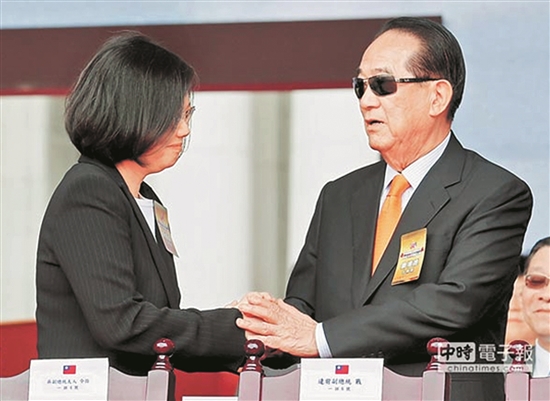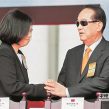
Taiwan’s Election Results Reflect Shift in Attitudes
Publication: China Brief Volume: 16 Issue: 4
By:

This February marks the 69th anniversary of the 228 Incident in Taiwan, an outpouring of public rage that laid the foundations for Taiwan’s opposition parties and eventual democratic transition. Since the Chinese Nationalist party Kuomintang (KMT) relocated from Mainland China to Taiwan in 1949, Taiwan has struggled with its several cultural and political identities. On January 16, Taiwan voters elected Tsai Ing-wen as their first female president and only the second Democratic Progressive Party (DPP) president since the KMT assumed power in Taiwan (CNA, January 16). Securing 68 out of total of 133 seats, the DPP also won its first-ever majority in the Legislative Yuan (CNA, January 17). Traditionally, Taiwan watchers believed that the KMT-led Pan-Blue Coalition (泛藍聯盟) enjoys a larger support base than the pan-green alliance led by the DPP. In his recent speech in Washington, D.C., DPP’s Secretary-General Joseph Wu questioned the existence of a KMT-leaning majority based on the results of the 2016 and earlier 2014 elections. [1] Data from a series of Taiwan-wide surveys also indicate that support for the DPP has risen significantly since 2013. [2] These unprecedented election results beg the question: is Taiwan experiencing a fundamental shift in its political landscape?
Voter Attitudes
Such a shift will mean a major change in the size of a party’s base of support, which has traditionally been based largely on party loyalty. However, in the January elections, multiple factors beyond voter’s party affiliation played a role. One salient reason was continuing discontent with the outgoing Ma Administration’s policies. Dissatisfaction with the Ma Administration was strengthened by the Sunflower Student Movement of March 2014, a series of demonstrations and government building sit-ins in response to the death of a young army conscript due to negligence (China Brief, April 9, 2014; Taiwan Indicators Survey Research, January 14). Other concerns about Taiwan’s economic competitiveness, food-safety scandals, income distribution, and the price of housing also contributed. This dissatisfaction with Ma Ying-jeou’s administration and the KMT’s deteriorating image likely drove many Pan-Blue supporters either to vote for James Soong, the leader of a spinoff party from the KMT, or not vote at all. The argument helps explain the significant improvement in Soong’s share of votes this year (12.84 percent in 2016) compared to the presidential elections four years ago (2.77 percent in 2012), and a historically low turnout with only 66 percent of the eligible electorate voting. The KMT could also lose the votes from independent voters, which accounted for 43.4 percent of people, according to a 2015 survey. [3] Unforeseen events could also play a role in affecting the election outcome. The Chou Tzu-yu incident, which occurred shortly before the election, involved a teenage Taiwanese singer who was forced by her South Korean company to apologize for waving the island’s flag on a South Korean television show after the move irritated China. The move was viewed as degrading to Taiwan’s sovereignty, and prompted many voters to choose the DPP.
Even though surveys have shown the numbers of respondents who claim the DPP as their party affiliation has increased since 2009—and has grown even larger than the KMT’s share of the electorate since 2013—it is important to note that this change in public opinion could be temporary. [4] Over the past fifteen years, there is a discernable trend in which the newly-elected party initially enjoys a large boost to the number of voters claiming it as their affiliation, which then gradually evaporates while the opposition party would experience a steady growth after the elections (Taiwan Indicators Survey Research, February 3). This phenomenon could be attributed to the intense scrutiny by the general public, civic organizations, and opposition parties after the elections, which make it easy for the ruling party to fail people’s expectations. Thus, the DPP’s base of support, which currently appears strong now, will likely be tested when Tsai Ing-wen takes office on May 20.
Determining Party Affiliation
It is worth noting that the way people select their party affiliation is changing. Traditionally, people’s party affiliation in Taiwan was determined by how they saw Taiwan’s ultimate status vis-à-vis the Mainland: whether they supported Taiwan’s unification with the Mainland or if they backed Taiwan’s independence. By itself, this question has a number of determinants including ethnicity (Han-Chinese, or one of several Chinese and ethnically distinct aboriginal minorities) and family history (if, for example, one’s family was one of those that moved to Taiwan during the civil war). However, how people choose to align themselves with a party has grown beyond the independence-unification dichotomy.
Especially over the last nine years, polling results have tracked the growth of a distinct Taiwanese identity that blends and crosses traditional demographics. Since 2007, respondents to an annual poll have chosen “Taiwanese” as the top response when asked to describe their identity out of a variety of options—including “Chinese” and “both Taiwanese and Chinese”—with the most recent survey recording 59 percent as listing “Taiwanese.” [5] When people decide their party affiliation today, they consider a party’s capabilities and will to maintain—and even safeguard if necessary—what they consider to be this Taiwanese identity. However, while a simple majority of people have regarded themselves as “Taiwanese” since 2009, the trend does not proportionally reflect on people’s support for “Taiwan independence,” which has remained at around 15 percent. People in Taiwan are also continuously concerned about whether a political party can maintain peace and stability across the Taiwan Strait. A downturn in Taipei’s relationship with Beijing would mean a loss of economic opportunities from the bilateral economic relationship with the Mainland and Beijing-led multilateral agreements, such as the Regional Comprehensive Economic Partnership (RCEP). A long-standing fear of Mainland military reprisals against Taiwan in response to any perceived movement toward a declaration of formal independence also prompts people to choose a party that can manage ties with Beijing. While Beijing has expressed its desire to peacefully unify with Taiwan, it has reserved the right to use force against Taiwan if necessary, repeatedly warning that it opposes any form of “Taiwanese independence separatist activities in the international arena” (Xinhua, June 10, 2015). The promise of suggested compromises, such as “One Country Two Systems” (一国两制), have faded due to tesnions in Hong Kong, the supposed model for integration with the mainland (China Brief, October 23, 2014).
These two competing explanations of people’s choice of maintaining the “status quo” with the Mainland and leaving the future relationship undecided, an option that has led to a recent uptick in asking about Taiwan’s future. [6] The polls arguably show that, when given a choice of how they wish Taiwan’s relationship with the Mainland to proceed, “maintaining the status quo indefinitely” has risen to second place since 2002. The word “indefinitely” implies a permanent separation from the Mainland, giving a clearer picture that the Taiwanese identity is growing.
DPP-Party Building
The DPP’s stance can win the public’s trust in its ability and determination to maintain and advocating for a Taiwanese identity. However, to expand its support base, the DPP still needs to reassure the electorate that its tense relations with Beijing are a thing of the past. In fact, the DPP has been cautiously addressing cross-Strait relations during the party election campaign. In the second televised presidential debate, Tsai Ing-wen promised a “no provocation, no surprises” cross-Strait policy (DPP, January 8). Tsai’s victory speech also stated that her administration will “maintain the status quo for the peace and stability across the Taiwan Strait” (DPP, January 16). Even after the election, DPP’s Secretary-General Joseph Wu tried to tone down the China element in the elections. He argued that the election result couldn’t be interpreted as “China’s defeat” because the cross-Strait relationship was “not a salient issue in the campaign.” [7] These statements are intended to assure on both sides of the Taiwan Strait and abroad that the DPP will take a moderate stance in cross-Strait relations to manage its ties with Beijing.
Beijing’s Doubts
Whether people will trust in DPP’s capability in handling relations with Beijing depends on the Mainland’s response. Beijing has been disturbed by the existence of the DPP’s 1991 charter that supported Taiwan’s de jure independence from China. Also, the DPP’s 1999 Resolution on Taiwan’s Future, which Tsai Ing-wen has confirmed as the party guidelines today, stated that Taiwan should “renounce the ‘one China’ position,” which fundamentally contradicts Beijing’s one-China principle (DPP, July 20, 2014). Similarly stirring Beijing’s unease is that Tsai Ing-wen has declined to endorse “the 1992 consensus,” which accepts “one China” but allows strategic uncertainty surrounding its precise definition. Regarding the 1992 consensus, Joseph Wu clarified that Tsai Ing-wen has never denied “the historical fact” of the cross-Strait dialogues in 1992, and has acknowledged “the spirits” of the two sides at the time to “set aside differences to seek common ground that formed the basis of the 1992 cross-Strait meetings.” [8] Even given Wu’s remarks on the disconnect between the election results and independence, Beijing likely views the Taiwanese electorate’s rejection of the Ma Administration as a worrying corollary to the opinion surveys.
Conclusion
In the 71 years since Taiwan reverted to Mainland Chinese control from Japanese occupation, the island has changed enormously. The 228 Incident, just a year after the KMT began to consolidate control on the island, highlighted the difficulties of integrating Taiwan into a larger Chinese polity. This most recent election, the sixth Presidential election since Taiwan embraced democracy, has shown that the Taiwanese people’s attitudes have shifted dramatically. Beijing’s primary concern remains the same: “the fact that the Mainland and Taiwan belong to one China has never changed, and will not change” (Xinhua, January 21). Beijing is thus less likely to accept Tsai’s interpretation of the 1992 consensus, which emphasized on the “historical fact” and the “spirits” of the cross-Strait dialogues in 1992 rather than accepting the one-China principle.” To Beijing, it is the one-China principle that allows the cross-Strait exchanges to begin, not the meeting itself, the phraseology of the “1992 consensus,” or the spirits of “seeking common ground despite differences” that Tsai said to enable the meetings. But this does not mean there is no flexibility in Beijing’s Taiwan policy. The unstoppable people-to-people interactions across the Taiwan Strait and Beijing’s ongoing strategy to win hearts and minds in Taiwan through cultural exchanges play a part in Beijing’s Taiwan policy. While the cross-Strait relations will not immediately suspend after Tsai takes office on May 20th, the question is how deep and far the cross-Strait exchanges will go if accepting one-China principle is not an option for the DPP.
Emily S. Chen is a Silas Palmer Fellow with the Hoover Institution, a Young Leader with the Pacific Forum CSIS, and a Non-Resident Fellow with the Center for the National Interest. Her writings have been featured in, among others, CSIS’s PacNet Newsletter, China Hands and CogitAsia. She holds a Master’s degree in East Asian Studies from Stanford University.
Notes
1. Joseph Wu, “Taiwan after the KMT: Interpreting the 2016 Election,” CSIS, January 19, 2016. <https://csis.org/files/attachments/20160119_Wu_Speech.pdf>.
2. “Party Preferences Trend Distribution in Taiwan (1992/06~2015/06): Trends in Core Political Attitudes Among Taiwanese” Election Study Center, National Chengchi University, July 9, 2014. <https://esc.nccu.edu.tw/course/news.php?Sn=165>.
3. Ibid.
4. Ibid.
5. Ibid.
6. Ibid.
7. Joseph Wu, “Taiwan after the KMT: Interpreting the 2016 Election,” CSIS, January 19, 2016. <https://csis.org/files/attachments/160119_csis_brookings_taiwan_transcript.pdf>. p. 6.
8. Ibid. p. 18.





